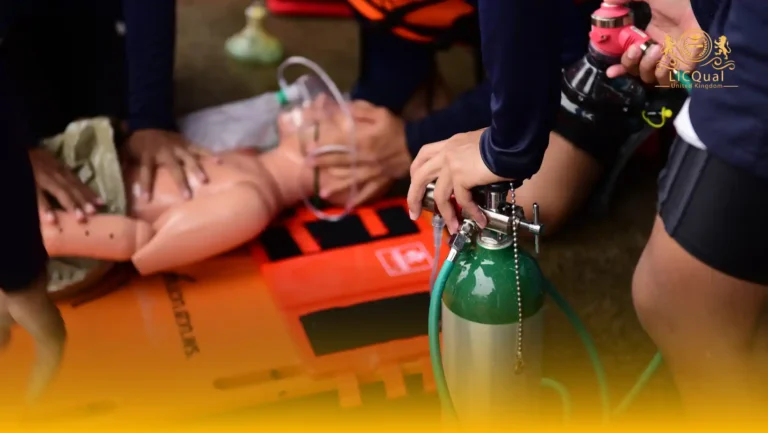The LICQual Level 2 Award in Manual Handling is a vital training program designed to equip workers with the essential knowledge and practical skills needed to perform manual handling tasks safely and effectively. This course is ideal for individuals in physically demanding roles across industries such as construction, warehousing, healthcare, logistics, and manufacturing. Understanding safe manual handling techniques not only helps reduce workplace injuries but also promotes a proactive health and safety culture.
The course provides a comprehensive overview of manual handling principles, including the risks associated with lifting, carrying, pushing, and pulling objects. Learners will explore the causes of common musculoskeletal injuries and understand how poor posture, overexertion, and improper techniques can lead to long-term health problems. The training emphasizes correct body mechanics, ergonomic principles, and the importance of pre-task assessments to minimize manual handling risks.
Practical demonstrations and scenario-based learning form a key part of the course, ensuring that learners can apply what they’ve learned in real-world settings. Participants will gain confidence in conducting manual handling risk assessments, identifying potential hazards, and selecting appropriate controls such as lifting aids or teamwork strategies. The LICQual Level 2 Award in Manual Handling also teaches how to recognize and report unsafe practices in accordance with organizational procedures.
This certification is particularly beneficial for employees who regularly move materials or assist in transporting loads as part of their job roles. By completing the LICQual Level 2 Award in Manual Handling, learners demonstrate their commitment to workplace safety and their readiness to reduce the risk of injuries for themselves and others. Employers also benefit from fewer lost workdays, improved staff morale, and compliance with health and safety regulations.
In today’s work environment, the ability to handle loads safely is a critical skill. The LICQual Level 2 Award in Manual Handling empowers individuals and organizations to prevent injury, enhance efficiency, and meet regulatory expectations. Whether you’re entering a labor-intensive industry or looking to refresh your safety knowledge, this course provides the practical training and formal recognition you need to handle materials with care and confidence.
Course Overview
Qualification Title
LICQual Level 2 Award in Manual Handling
Total Units
6
Total Credits
6
GLH
12
Qualification #
LICQ2200440
Qualification Specification
To enroll in the LICQual Level 2 Award in Manual Handling applicants must meet the following criteria:
|
Qualification# |
Unit Title |
Credits |
GLH |
|---|---|---|---|
|
LICQ2200440-1 |
Advanced Understanding of Manual Handling Risks and Ergonomics |
1 |
2 |
|
LICQ2200440-2 |
Manual Handling Legislation and Organisational Compliance |
1 |
2 |
|
LICQ2200440-3 |
Conducting Risk Assessments for Manual Handling Tasks |
1 |
2 |
|
LICQ2200440-4 |
Control Measures and Safe Handling Equipment Use |
1 |
2 |
|
LICQ2200440-5 |
Manual Handling in High-Risk Environments (e.g., healthcare, construction) |
1 |
2 |
|
LICQ2200440-6 |
Implementing Safe Systems of Work in Manual Handling |
1 |
2 |
By the end of this course,applicants will be able to:
1. Advanced Understanding of Manual Handling Risks and Ergonomics
- Explain the key ergonomic principles relevant to manual handling tasks.
- Identify and evaluate the physical, environmental, and task-specific risk factors.
- Describe how poor ergonomics and repetitive strain contribute to musculoskeletal disorders.
- Apply knowledge of body mechanics to reduce the risk of injury during manual handling activities.
2. Manual Handling Legislation and Organisational Compliance
- Identify current legislation and regulations governing manual handling in the workplace.
- Understand the legal duties of employers and employees in ensuring manual handling safety.
- Explain how organisational policies support legal compliance and risk management.
- Recognize the importance of documentation and training in demonstrating due diligence.
3. Conducting Risk Assessments for Manual Handling Tasks
- Describe the steps involved in performing a manual handling risk assessment.
- Identify hazards and assess the likelihood and severity of potential injuries.
- Recommend appropriate control measures based on the risk level identified.
- Record and communicate findings in accordance with workplace procedures.
4. Control Measures and Safe Handling Equipment Use
- Identify various types of mechanical and manual handling aids.
- Understand the correct selection and use of equipment to support safer handling.
- Explain how control measures such as job rotation and team handling reduce risk.
- Demonstrate knowledge of maintenance and inspection requirements for handling tools and aids.
5. Manual Handling in High-Risk Environments (e.g., healthcare, construction)
- Recognize the unique manual handling challenges in high-risk industries.
- Apply tailored techniques for patient handling, heavy lifting, or confined space work.
- Understand the role of sector-specific protocols and safety standards.
- Identify additional risk controls needed when handling loads in dynamic or hazardous conditions.
6. Implementing Safe Systems of Work in Manual Handling
- Explain the components of a safe system of work (SSOW) for manual handling.
- Develop or follow procedures that ensure safety during manual handling tasks.
- Monitor and report unsafe practices or equipment malfunctions.
- Contribute to continuous improvement by suggesting updates to manual handling procedures.
This diploma is ideal for:
- Employees who regularly perform manual handling tasks in their job roles
- Workers in sectors such as logistics, construction, healthcare, retail, and manufacturing
- Team leaders and supervisors responsible for monitoring manual handling activities
- Individuals with a Level 1 qualification looking to advance their knowledge and skills
- Staff members involved in risk assessment or implementation of safe handling procedures
- Employers aiming to ensure compliance with manual handling legislation
- Health and safety representatives seeking to expand their competency in handling risks
- Temporary or contract workers who need enhanced manual handling awareness
- Individuals preparing for a role in health and safety or occupational risk management
- Employees returning to the workforce who require upskilling in workplace safety
- Apprentices or trainees in physically demanding industries
- Facilities and warehouse staff responsible for moving or storing heavy goods
- Cleaning and maintenance personnel handling equipment or supplies
- Forklift operators or warehouse assistants seeking broader safety training
- Volunteers or staff in care settings involved in assisting patients or service users
- Small business employees who manage manual handling without formal safety training
- Anyone aiming to reduce personal injury risk and contribute to a safer working environment
Assessment and Verification
All units within this qualification are subject to internal assessment by the approved centre and external verification by LICQual. The qualification follows a criterion-referenced assessment approach, ensuring that learners meet all specified learning outcomes.
To achieve a ‘Pass’ in any unit, learners must provide valid, sufficient, and authentic evidence demonstrating their attainment of all learning outcomes and compliance with the prescribed assessment criteria. The Assessor is responsible for evaluating the evidence and determining whether the learner has successfully met the required standards.
Assessors must maintain a clear and comprehensive audit trail, documenting the basis for their assessment decisions to ensure transparency, consistency, and compliance with quality assurance requirements.







